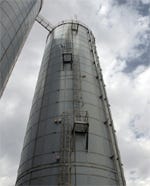Tank Installation Process Keeps Field Crews Grounded
November 6, 2007
|
Tank Connection has enhanced safety for the installation of field-erected dry bulk storage tanks. |
|
1 |
|
2 |
|
3 |
|
4 |
|
5 |
|
6 |
|
7 |
|
8 |
A safe work environment is obviously a top priority in all industries. Whether you work in an office, a manufacturing plant, or construction, safety is a factor that must be monitored continuously. Innovations to enhance safety are sought every day. Tank Connection, a leader in the supply of dry bulk storage and handling equipment, has enhanced safety for the installation of field-erected dry bulk storage tanks.
Field-erected bolted tanks began decades ago in the “oil patch” territories. Tanks were developed wherein steel panels were formed and flanged, then bolted together to make a tank for the storage of oil and liquid materials. This methodology transformed through the years to include designing these tanks to store dry materials. However, with this transformation, the field construction techniques have never been considered safe construction practices.
In the past, tank constructors used scaffold brackets and wooden planks to scale the exterior of the tank during construction. Depending on the tank height, workers would be several stories off the ground with nothing but lines and harnesses to ensure their safety. Today, plant managers must ensure the safety of all workers on site. This is why Tank Connection has taken the safety of bolted tank construction to the next level of field performance.
By utilizing a series of synchronized, hydraulic screw jacks at grade level, workers do not have to leave the ground to install a field-erected bolted tank. The system is carefully designed for each application, taking into consideration the tank diameter, height, dead weight, wind conditions, etc. Tank Connection is also the manufacturer of a proprietary jacking system.
The safety consciousness of the company’s field construction services has been praised by engineers, plant managers, and safety trainers. One safety coordinator at a major chemical plant remarked, “We have taken the old method of tank installation and made it into a training session of what not to do. It is the only tank construction process available in the marketplace today that can be considered ‘safe field construction.’”
Regardless of the tank size, this jacking system has become a preferred choice for field-erected bolted tanks worldwide.
The installation of a tank involves several steps, as illustrated in the accompanying photographs. 1: Erection begins with the “starter” or anchor ring that is anchored to the foundation. Next, the tank jacks are put into position. 2: Note the jacks being anchored to the slab as well as the “starter” ring attached to the anchor bolts. 3: The construction of the tank begins with the upper-most ring of the tank. 4: Sidewall sheets are added from the ground level until the ring is complete. The ring is raised with the jacks, and the next ring down is added. 5: Sidewall sheets are added in a counterclockwise direction. 6: Once the ring is complete, the tank is lifted to allow the installation of the next ring. 7 and 8: At any time, the tank can be lowered and attached to the “starter” ring to allow anchorage for leaving the tank overnight, over the weekend, or in the event of a sudden increase of wind or a storm.
Tank Connection LLC, Parsons, KS, offers bolted tanks, field-weld and shop-weld storage tanks, and integrated storage systems. The company’s in-house services consist of consulting, engineering design, specification development, equipment quotes, and field installation services. For more information about the company, call 620-423-3010 or visit www.tankconnection.com.
You May Also Like











